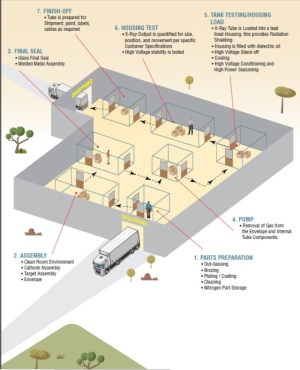by
Lisa Chamoff, Contributing Reporter | November 12, 2014
From the September 2014 issue of HealthCare Business News magazine
The health care landscape is always shifting, but some things have remained fairly constant, including the high cost of X-ray tubes.
It’s no secret that these powerful, vacuum sealed, and fragile tubes are one of the most important components of a CT scanner or X-ray system. And while most imaging professionals know how they work, the process of how these tubes are created is not common knowledge.
For its annual industry sector report, DOTmed Healthcare Business News decided to demystify the X-ray tube manufacturing process a bit, speaking with two of the major players — Varian Medical Systems, which builds tubes and private labels equipment for OEMs, and Dunlee, a division of Philips Healthcare which, in addition to supplying its parent company, also makes private label tubes for other manufacturers and CT tubes for the mulit-vendor marketplace.
The hope is that when it again comes time to replace the tubes, you’ll have a clearer picture of where your money is going.
Glass fabrication
Photo courtesy of Varian
Materials
Before things even get going in the factory, it all starts with the materials, which are the most expensive part of the manufacturing process. The refractory metals — oxygen free high thermal conductivity copper, high grades of nickel, tungsten, silver, rhenium, and Kovar — are costly and the prices often fluctuate. The metals are mined and sourced from several different countries including China, Russia, Australia, Peru, and Canada.
Glass shop
Photo courtesy of Dunlee
Parts are also sourced from a few suppliers. For example, targets, big metal pieces made out of refractory metals, generally tungsten, that produce X-rays when struck by electrons, are only made by a few big companies, such as GE Healthcare and Plansee. Both Dunlee and Varian purchase targets from these outside companies, because the level of investment it would take to produce them would be high, according to Mark Jonaitis, general manager of X-ray tube products at Varian.
Target vacuum furnace
Photo courtesy of Varian
1. Parts preparation
Preparing the expensive materials also requires a major capital investment. Inside large furnaces that cost a few million dollars and range in size from 10 square feet to 50 square feet, all gases and other materials are removed from the metal components to ensure there’s a solid vacuum environment — kind of like water being wrung out from a sponge. Varian uses a variety of furnaces manufactured by Thermal Technology, Vacuum Industries, and Astro, to name a few. Dunlee also uses furnaces manufactured by Thermal Technology along with a variety of others including T-M Vacuum Products.
